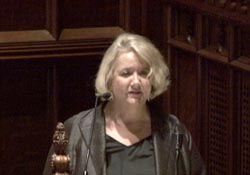She Bops!
If there is one truth that Lori Custodero holds self-evident, it’s that there’s no such thing as “too early” when it comes to learning music.
That idea is a core tenet of the research Custodero conducts as Associate Professor of Music Education at TC, and it’s a founding premise of WeBop!, the highly popular education program she developed at Jazz at Lincoln Center.
Honored by New York magazine as the city’s Best Music Class of 2012, WeBop! teaches the elements of jazz—including instrumental technique, rhythms, soloing, improvisation—to children ages eight months to five years old.
Jazz for 8-month-olds?
“Infants engage in a lot of jazz-type activity,” Custodero explains. In fact, not only do very young children have natural musical abilities, but music also is inherent in the relationship between infants and parents, whether it’s recognized or not as such. “Parents do a lot of improvising with babies.”
Especially fathers, as Custodero found out in a national
survey of parents of newborns that she carried out more than a decade ago. “We
asked what they sang to their babies. Moms were singing lullabies and composed
“songs.” Dads were making up stuff, though really, both parents do. it is so
intimate an act, that they keep it as a special secret communication between
themselves and their children
At WeBop!, the teachers and musical accompanists work with
parents and children together, using the elements of jazz to help guide and
make the most of the natural musicality that exists between them.
“It’s about the dyad of parent and child,” Custodero says. Which means that the children are not just learning; they’re also participating in teaching their parents.
For Custodero, a trained classical pianist turned education scholar who launched TC’s Early Childhood Music Education program upon joining the faculty in 1998, WeBop! is a perfect setting to put her research into practice.
“It’s a dream for me,” she says. “It’s so exciting to have a place where your philosophical and practical ideal of how children should be introduced to music can happen.”
Not that WeBop! is her only forum. At TC’s Rita Gold Early Childhood Center, Custodero leads her students in work with young children and their caregivers. She also works with outside organizations such as the New York Philharmonic, whose Very Young People’s Concerts program she helped design.
Earlier this year, Custodero joined with the Mingus Big Band and the Partnership for the Homeless in working with children from pre-school through high school in East New York. Each age group tackled a selected Charles Mingus tune and performed it with the Big Band in a special concert.
The youngest children invented a dance to accompany their Mingus song, “Boogie Stop Shuffle,” Custodero says. The middle group played bucket drums, made the sounds of honking horns and enacted stories that matched the music of Mingus’s “Nostalgia in Times Square.” The oldest ones wrote and sang lyrics to his “Fables of Faubus.”
“I don’t know who had more fun, the workshop leaders or the kids!” Custodero says.
As Custodero approaches it, music isn’t some complicated corpus of material that teachers impart to learners. Instead, it’s a kind of ambient, common property that offers everyone an active, creative role.
“It’s this idea of fluidity, this movement, and how everyone can find their place in it,” Custodero says. “Swinging doesn’t mean everyone playing solo at the same time, but that we learn to support and lead, both as teacher and students in the community of the class. I think that’s a really important construct for learning.”
Also central to Custodero’s method is the concept of flow experience, pioneered by psychologist Mihaly Csikszentmihalyi, which posits that people find the most enjoyment when engaged in activities that simultaneously challenge them and boost their confidence in their skills.
“If you’re skilled but not challenged, you’re bored,” Custodero says. “And if you’re not skilled and you’re challenged, then you’re anxious. But if you’re doing something that you perceive as challenging, and you also perceive yourself as having the skills to meet that challenge, then you’re having the time of your life.”
With its emphasis on improvisation, jazz is well suited for activities that cultivate this kind of learning experience, Custodero says.
“Improvisation does that,” she says. “You have a certain structure but within the boundaries there is freedom. You have clear goals; that’s important. But when teaching, children might have a better idea on the path to that goal. They’ll do something with the drum that you’ve never seen. Something must feel right about it for some reason, so let’s play with that a little bit.”
One of Custodero’s current studies investigates how children make music in public places: spontaneously singing, tapping and so on, on the subway, in stores, or walking down the street. “These environments are not constructed for music making, yet it goes on all the time,” she says.
The benefits of being attuned to how children create—where they find their challenges, and how they apply their skills—go well beyond music education, speaking to teaching writ large.
“Tuning in to children is so much more fruitful than forcing something for which the time or the mode of introduction is not right,” she says. “It forces teachers to really listen and watch what’s going on. It becomes a very effective and interesting way to live a teaching life.”
Published Monday, Aug. 20, 2012
